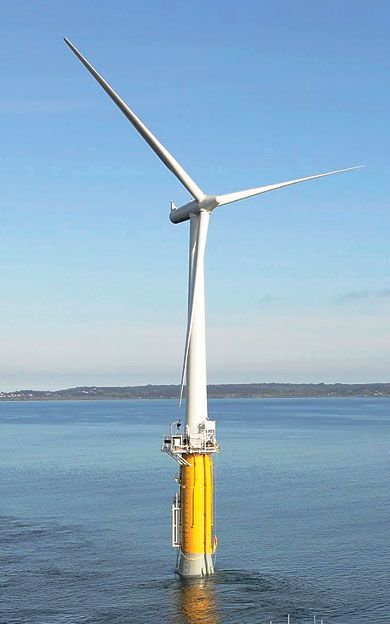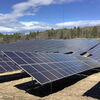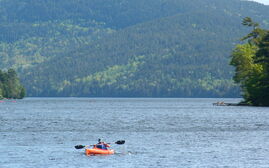Offshore wind plans vie for money, support
For more than six years, Habib Dagher has been championing the idea that offshore wind power can solve two of Maine's biggest economic problems — a declining manufacturing base and the net loss of $5 billion spent annually by Maine residents on oil and gas produced out of state. On May 31, that vision took a tangible step forward.
With hundreds watching and a big grin on his face, Dagher celebrated the launch of America's first floating offshore wind turbine at Cianbro Corp.'s plant in Brewer.
Named after the Roman god of the east wind — and a composite of the words 'volt,' 'turn' and U.S. — the 65-foot-tall VolturnUS prototype is a one-eighth scale model of the turbines the University of Maine hopes to install by 2016 in deep waters off Monhegan Island. It's now deployed in shallow waters off Castine, but will be anchored later this summer off Monhegan for testing in a deep-water environment.
"It's a unique design … the first of its kind in the world," says Dagher, UMaine's Bath Iron Works Professor of Structural Engineering who also serves as director of the Advanced Structures and Composites Center in Orono. "The floating platform's foundation uses concrete produced here in Maine. The turbine's tower is made out of advanced composites. With these advanced materials, we're looking at an asset with a life cycle that's three to four times — 60 to 80 years — greater than the 20-year life cycle of a typical offshore wind turbine. It's an asset that will keep producing power for up to 100 years."
And its location within the Gulf of Maine, where wind speeds are higher and more consistent than any onshore site and most offshore sites, is considered ideal. Maine's yearly offshore wind power potential is pegged at 156.6 gigawatts, equivalent to the power generated by 75 Hoover Dams.
"It's a huge natural resource," says Dagher. "We are energy-rich. We just haven't taken advantage of this resource."
But he also knows bigger challenges lie ahead if the UMaine-led consortium of Maine companies that collaborated in the construction of the VolturnUS prototype is to succeed in creating a commercially viable 170-turbine wind farm in the Gulf of Maine by 2030.
The wind energy industry, both offshore and onshore, has been dogged by questions about its cost and whether it can compete in electric power markets that increasingly are tapping natural gas as a low-cost energy source due to the rapidly expanding U.S. domestic production. Other headwinds threatening to stall Maine's fledgling wind power industry include investors' uncertainties about the future of the federal Production Tax Credit and the volatility of energy markets. On the political front, the Governor's Energy Office is calling for a reconsideration of the goals for wind power production set by the Maine Wind Energy Act in 2008.
UMaine's initiative
UMaine's immediate challenge, though, involves progressing to the next round of a competitive Department of Energy grant program to jumpstart an offshore wind industry. In the first round, it was competing against 70 other projects and was one of seven selected to receive $4 million in grants. A good indicator of how highly the DOE regards the Gulf of Maine's prospects for offshore wind energy is the fact that the rival Statoil Hywind Maine pilot project was among the other six DOE recipients.
But with only three $46.6 million grants being offered in the second round, it's unlikely the DOE will fund both Gulf of Maine projects. The grants to be awarded next spring are intended to advance the siting, construction and installation of the pilot projects, with an aim of achieving commercial operation by 2017. There are key differences between the projects, including:
- Technology: UMaine's $93.3 million project uses a unique floating platform technology and design while the $120 million Statoil Hywind Maine pilot project uses more traditional ballasted steel cylinders the Norway-based company has been testing since 2009.
- Scale: UMaine's pilot project calls for two 6 MW wind turbines with a 425-foot blade diameter being installed off Monhegan, while Statoil Hywind plans to install four 3 MW turbines with a blade diameter of up to 355 feet in waters 12 nautical miles southeast of Boothbay Harbor. The question is whether UMaine's larger-scale turbines will deliver twice the power of Statoil's smaller turbines.
- Maine impact: UMaine has pledged an unequivocal "Made in Maine" approach to design, construction and operations, while Statoil has given qualified assurances its Hywind project will use local Maine companies in the development, construction, installation and operation of its turbines.
Peter Vigue, chairman and CEO of Cianbro, shares Dagher's optimism that the VolturnUS prototype designed by UMaine and built by his company will beat Statoil for the DOE funding. On two key fronts, he says, the VolturnUS design should drive down construction, installation and maintenance costs of the commercial-size wind turbines, reducing the cost of wind energy to 10 cents per kilowatt hour and thereby make it very competitive:
- The construction materials of concrete and advanced composites will weather the harsh sea environment far better than steel, giving VolturnUS an 80-to-100-year lifecycle instead of 20 years.
- It can be built and assembled on land and then floated to its installation site. If it ever needs replacement or maintenance, it can be disconnected from its anchors and taken back to land.
Dagher says the VolturnUS prototype initially will be placed off Castine in water 90 feet deep, where dozens of sensors will measure its response to wave and wind conditions to see how well it matches predictions made during the design phase. Those tests also will measure performance of the unit's unique blade design, which includes a control system that senses the wind strength and direction and can pitch the blade for optimum power generation.
After a month or so of testing off Castine, Dagher says, the unit will be moved to a location off Monhegan for tests in water up to 800 feet deep. Later it will be brought back to the Castine site for additional study during the early winter months.
Dagher says UMaine will submit its application for the next round of DOE funding sometime in January and expects to hear by April whether it will receive one of the $46.6 million grants, which a consortium of Maine industrial partners has collectively agreed to match.
UMaine researchers say the economic impact of building a commercial offshore wind farm of 5000 MW capacity by 2030 could potentially attract $20 billion of private investment to the state, creating thousands of jobs.
Statoil's competing plan
Statoil, an international energy company based in Norway, is using its Hywind project in the Gulf of Maine to further test and evaluate improvements to the technology used by the world's first full-scale floating wind turbine located 6.2 miles off the coast of Norway. The $120 million project got a significant boost earlier this year, when the Maine Public Utilities Commission voted 2-1 to approve a term sheet granting Statoil a long-term price of 27 cents per kilowatt hour for energy produced by the four Hywind turbines. UMaine's project, at the moment, lacks a similar price guarantee.
"We are now in an early phase of the project and need to secure necessary permits and select suppliers before moving forward," says Anita Holgersen, stakeholder manager for the Statoil Hywind Maine project who replied in an email to a list of Mainebiz questions. "We have already committed to use local Maine suppliers to the maximum extent. We also are positioning for the next round of the Department of Energy funding."
Holgersen characterizes the Gulf of Maine project as a test of "known technologies in a completely new setting" and cites the following as advantages of Statoil's Hywind approach:
- Identical substructures, which can be mass-produced, facilitate installation.
- Assembly, to a large degree, will be accomplished onshore and in sheltered waters with high work efficiency, reducing the weather risk and the dependence on specialized, high-cost vessels.
- Conventional offshore wind turbines are used, which reduces costs.
Holgersen says Statoil has not set a target date for a large-scale commercial offshore wind farm, but expects "10-to-15 cents per kilowatt hour will be a realistic target for the floating offshore wind technology in a large park, based on mature market perspective. With this price level, floating offshore wind will be competitive and offer good business cases in a number of markets … We have already started mapping possible business cases for a large park and see an interesting potential in Maine — to be verified by the experience from this process."
Installation date for the four-turbine Hywind Maine project is tentatively set for 2016.
What's best for Maine?
Patrick Woodcock, director of the Governor's Energy Office, says Gov. Paul LePage's position on wind power, both onshore and offshore, isn't hard to understand. "The bottom line of our energy policy is that it must help Mainers who are really struggling with high heating costs and high electricity bills," he says.
While he acknowledges the Maine Wind Energy Act enacted in 2008 helped jumpstart an onshore wind industry in Maine, Woodcock says it has failed to lower electricity costs. Absent that, he says, the governor believes the ambitious wind energy goals set by the act need to be reevaluated.
A LePage-backed amendment to review the 2008 act's wind energy goals — 2,000 MW of installed capacity by 2015; 3,000MW by 2020, including 300 MW or more offshore; at least 8,000 MW by 2030, including 5,000 MW offshore — was removed from the sweeping omnibus energy bill lawmakers approved in a 28-7 Senate vote and a 131-7 House vote.
"The Legislature appears to be moving in the direction of continuing to study the Wind Energy Act in its entirety," Woodcock says. "It's disappointing that we can't incorporate some serviceable modifications that we don't believe are political or need to be studied any further."
Woodcock, who spoke at the VolturnUS christening in Brewer on May 31, says offshore wind industry's potential for creating new manufacturing opportunities in Maine is a valid selling point. "The university has done an effective job of realizing the cost pressures on offshore wind energy have to be minimized," he says. An example he points to is the use of concrete and advanced composites to lower the lifecycle costs of the VolturnUS wind turbine platform, helping to reduce the cost of the electricity if the full-size units are deployed.
But that Maine-based innovation might never come to fruition, he says, due to the Maine Public Utilities Commission's decision earlier this year granting the Hywind project a 20-year price guarantee of almost $200 million for the electricity it will generate.
"What we've done, unfortunately, is give a leg up to one of the university's competitors that could potentially put the university at a disadvantage," he says, still chafing at the PUC decision he characterizes as "antithetical to improving Maine's business climate and reducing the energy bill burdens on Maine families."
Woodcock also challenges the economic benefits of the Hywind term sheet approved by the PUC.
"The specific requirements that would bring long-term jobs to Maine are undefined," he says. "They were 'aspirational' not tangible. We should be talking about specifics. It's not intrinsically great to have a wind farm off the coast of Maine. We want it to be constructed by Mainers and provide tangible benefits to Mainers."
Another late change to the omnibus energy bill, submitted the first week of June by the LePage administration, would have allowed UMaine to compete for ratepayer support and seek PUC approval of a long-term energy contract if the Statoil Hywind Maine project misses its financing or construction goals.
That amendment also was struck from the bill, but as late as June 19 Woodcock was scrambling to salvage the governor's bid to create a new PUC process allowing UMaine's pilot project to be evaluated against Statoil's. At press time, LePage had not signed the bill into law and it wasn't clear if lawmakers would reopen the omnibus energy bill to include the amendment.
PUC Commissioner David Littell, who was joined by PUC Chairman Thomas Welch in the 2-1 vote approving Statoil's term sheet, in his written opinion characterizes it as "exceptionally favorable to Maine," citing the company's willingness to invest $120 million in the Hywind project "with far below market returns on its investment."
Littell disputes Woodcock's characterization of the Hywind project as a $200 million cost to Maine ratepayers, saying it's more in the range of $57 million to $84 million based on a present value calculation used by the PUC in forecasting future energy prices. He also notes that no payments will be made until energy is actually delivered to Maine's electrical grid.
"Statoil stands to lose all of its $120 million-plus investment if it fails to build a successful project," Littell concludes. "The Hywind project offers financial terms that are tangible and extremely advantageous to Maine with energy and economic benefits that may be transformative."
Wind champion
Paul Williamson, director and industry coordinator of Maine Ocean & Wind Industry Initiative, acknowledges market forces, such as lower-cost natural gas and uncertainties about the federal Production Tax Credit, have slowed onshore wind investments to the point where the first target goal of 2,000 MW by 2015 is unrealistic, given that Maine only has 435 MW of capacity operating now.
But he believes it would be a big mistake to scrap the goals entirely.
Pointing out that in three leading wind power states — Iowa, Texas and Kansas, which combined have about 19,000 MW of installed wind capacity — the Republican governors have been staunch supporters of adding more turbines, Williamson says setting ambitious wind energy goals is what "drives business to your region and it drives development." Iowa's Gov. Terry Branstad, he adds, recently called for a $4.9 billion further investment in wind power, which now represents more than 20% of Iowa's electricity generation.
"One of the limiting factors of the Maine goals is that there has been a lack of commitment to those goals, a lack of teeth ... to make them happen," he says. "Texas, for example, has really claimed leadership on wind power largely because of the policies that were put into place when George W. Bush was governor. They're reaping huge rewards from it now."
On the state level, then, Williamson says keeping and meeting the target wind energy goals is critical.
Nationally, he says, the wind industry is crafting a proposal to keep the federal Production Tax Credit in place, but phase it out over the next four to six years. The credit, which provides a 2.2 cents per kilowatt hour benefit for the first 10 years of a wind power facility's operation, has helped drive wind power development over the past decade. But Congress has allowed it to expire on four occasions since it was initiated with the Energy Policy Act of 1992, and statistics compiled by the DOE show a direct correlation between the tax credit's on-again, off-again status and the boom-bust cycle of development that has plagued the wind industry. The uncertainty hampers financing of new projects and creates delays that slow the learning curve and technology improvements that continue to drive down wind energy's costs, according to industry watchers.
"The cost of wind power has been lowering each year for the last decade, and we expect it to be fully competitive within the energy market in the next four to six years," Williamson says. "In fact, in comparison to many other new generation sources of energy it already is competitive at this time. So the industry would like to see, not an extension of the tax credit, but a phase-out that allows proper business planning to occur over a long period of time. Major investments of hundreds of millions of dollars aren't usually made unless you're aware of what your policy will be over a number of years."
Like the onshore target goals, Williamson says keeping the 5,000 MW offshore goal by 2030 is critical.
"It's establishing those goals and then committing to them that generates enough of a market so that people are willing to commit to those ventures," he says. "If you don't commit to those goals ... you never have enough mass to really drive the investment to local manufacturing."
Prognosis? Uncertain
Charles Colgan, professor of public policy and management at USM's Muskie School of Public Service, has analyzed both the present and future economic impact of onshore and offshore wind projects on Maine's economy. He calls the job generation thus far "important" and agrees with Williamson and others that the potential for creating high-paying jobs and significantly more renewable energy is huge. But he agrees with Woodcock that there needs to be tangible benefits in terms of Mainers' energy costs. And that's not an easy question to answer, even for an economist.
"It's open to so many different variables," he says.
In 2012, natural gas was the primary fuel for almost 50% of Maine's electricity-generating capacity — mirroring its magnitude throughout New England and contributing to a nearly 23% decline in wholesale electricity prices for the region, according to ISO New England, the operator of the region's bulk power system and wholesale electricity markets.
Colgan says there's no question that's a benefit to Maine's economy and is helping to reduce the state's electricity costs. But he wonders about natural gas's long-term pricing stability in world energy markets in the aftermath of the Fukushima nuclear disaster in Japan, saying, "The Japanese are absolutely desperate for natural gas and are going to pay huge sums for it." And he shares LePage's opinion that Hydro Quebec bears a closer look.
"It is clear Maine has a vast array of choices, it's not clear which one is the best," he says. "Obviously, right now, natural gas alters the competive situation for onshore wind. But does it alter it over a 25- to 30-year period? I don't think anybody has the answer to this."
Colgan acknowledges UMaine might face an uphill battle against an energy company with a presence in more than 30 countries. The performance of the VolturnUS pilot project, obviously, is paramount.
"Habib and Peter are saying, 'Let us get going. Give us a chance to improve our performance and shorten the learning curve so the price of generating electricity will come down.' At this moment, they just don't know how long or how steep that learning curve will be."
Read more


















Comments